Tiva to Tekoa
This article first appeared in the Dec. 2016/Jan. 2017 issue of Adventure Cyclist magazine.
We pedaled up the gradual grade of a crushed gravel trail on a late mid-May morning. It had taken us three years of patience, failures, tears, and determination to get to this point, which was more physical and mental preparation than for any trip we’d ever attempted. We weren’t trying to break any records or travel through vast uncharted regions. We weren’t pedaling the globe or crossing a continent. We were just riding a portion of our state … with our dog.
Tiva (a.k.a. the Reluctant Traveler) is a 40-pound Formosan mountain dog rescued from a garbage dump in Taiwan. She came to us when she was six months old. I wrote a column about her in the February 2014 issue of Adventure Cyclist.
To recap, Tiva was one of the most frightened little animals I’d ever encountered. Any sound remotely associated with a garbage truck (diesel engines, back-up beeps, or the hiss of air brakes) sent her scrambling under our bed or diving into her crate.
Just how reluctant was our Reluctant Traveler? It took us two full months to get her to successfully walk around one city block.
I’d like to think that I was always patient and gracious, but in reality I was far from it. I felt trapped and angry. It wasn’t my idea to get a dog. I remember at one point looking at my wife Kat and spitting out the venomous words, “You did this to me.”
And then Tiva would look up at us and wag her tail, and tears would flow.
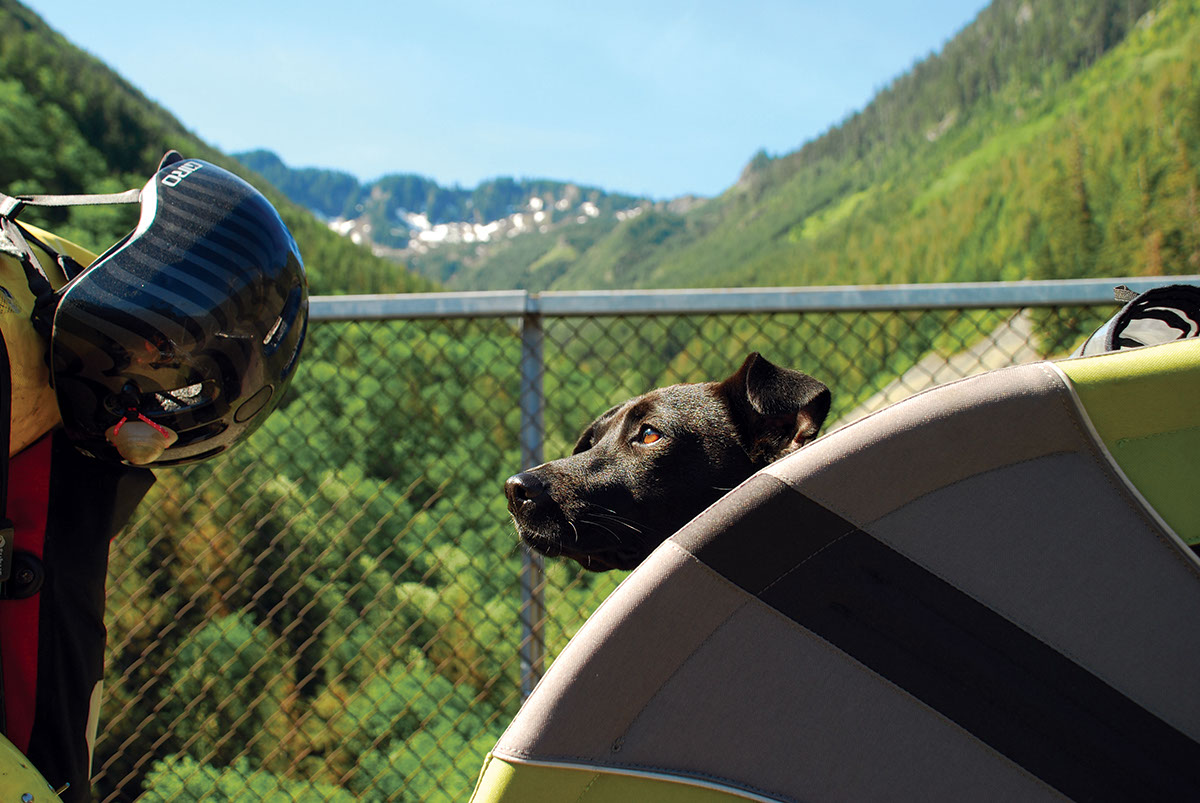
In an insanely optimistic moment, we bought a dog trailer on Craigslist — a really nice one by Dutch Dog Design. We got it on the cheap because the prior owner, who had a big black lab, dumped the trailer when he took a corner too fast. Afterwards the lab wouldn’t go anywhere near the trailer. “He’s a smart dog,” the guy commented.
We set up the trailer in our living room where, for the next several months, it served as nothing more than a treat-delivery device. We’d call out, “Load it up,” and Tiva would hop in the trailer and pop her head out the top for a piece of pork loin.
Then we moved the trailer outside, which doesn’t seem like a big deal unless you understand the world of a timid rescue dog … EVERYTHING new is scary. It took weeks, but she finally got in the trailer outside. After another month, and God only knows how much pork loin, we were able to walk the trailer around the block with Tiva in it.
Several months later, it was time to attach the trailer to the bike. We knew if Tiva encountered a truck on her first ride, she’d be like that big black lab, and we’d be the ones selling the trailer on Craigslist. We’d heard of the John Wayne Pioneer Trail that begins in Cedar Falls, about 35 miles outside of Seattle, where we’d have zero chance of encountering a FedEx truck.
I’d never been a huge fan of rail trails. I love to cycle up and coast down hills and mountains. Trails constructed on old railroad right-of-ways tunnel through the mountains and bridge across the valleys. What’s the point?
Well, now the point was that we were going to be able to ride our bikes with our dog, if only for a mile, after two years of trial and error.
And you know what? It worked. Sort of. She didn’t love it — she preferred running alongside it, and she cowered a bit when we put her in. But, on the bright side, she didn’t try to gnaw her way out of the trailer in sheer panic. We were ecstatic. We’d learned to celebrate all victories, no matter how small.
Where could we go from here? We dreamed big. We set our sights on riding the John Wayne Pioneer Trail all the way to the small town of Tekoa (pronounced tea-co), just short of the Idaho border.
We did a practice overnight on the John Wayne and another on the Banks-Vernonia Trail in Oregon. The more we pedaled with her, the more confident she became. Her trailer and our tent became safe and secure spaces. Tiva’s tail spent more time flying like a flag instead of tucked between her legs.
The route would be over 300 miles, and we planned for nine days.
On a cool, clear May morning, our friend Dave Maynard dropped us off at the trailhead. We loaded our food and camping gear, attached the trailer to my bike, called for Tiva to “load it up,” and we were off.
The trail climbs 22 gradual miles up to the Snoqualmie Pass tunnel. It parallels I-90 but is far enough away that the traffic is a distant dull roar. The restored trestles provided the perfect vantage points for stunning views of the Cascades. The scent of Douglas fir and the delicate vine maples reaching out for stray patches of light and the ascending call of Swainson’s thrush reminded me of why I love living in the Northwest.
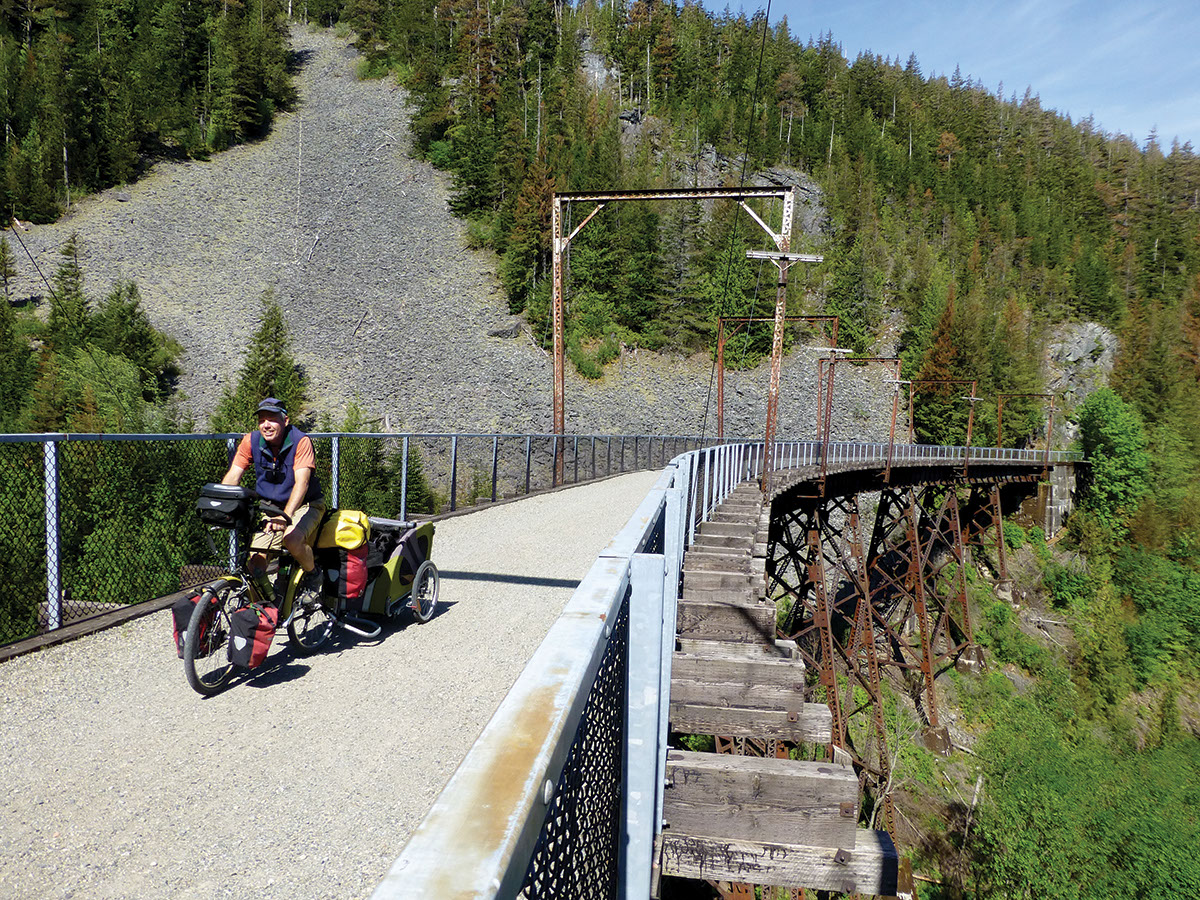
We let Tiva out of the trailer to run for three miles or so. When she is relaxed, her happy gait reminds me of a rocking horse. She would run ahead and toward Kat on the trail, then stop abruptly and turn around to check that I was on my way. She needed her pack to stay together.
We learned that one thing Tiva is not afraid of is the dark. The 2.3-mile Snoqualmie tunnel is the longest on the trail. We bundled up in our coats (tunnels are cold), strapped on our headlamps, and rode through it. Tiva curled up in her trailer and went to sleep. We camped the first night at Lake Easton State Park.
We spent the next morning slowly making our way down the trail, stopping to take photos of wildflowers and chatting with locals out biking, jogging, and walking the trail. At the old station at Cle Elum, we lingered long enough for Smokey’s Bar-B-Que to open so we could feast on some pulled pork, with Tiva patiently waiting for leftovers.
The trail veers away from I-90 and travels along the scenic Yakima River. We stayed with some wonderful Warmshowers hosts in Ellensburg (the largest town on the trail).
Past the town of Kittitas, the trail crosses the interstate and travels though the Yakima Army Training Center. The sound of the freeway quickly disappeared, and the trail now traversed rugged landscape. The sky opened up, the temperature climbed, and the grassy hills swayed with the breeze.
The old railbed wound through several rocky cuts. Tiva trotted alongside us as we slowly walked our bikes, weaving around the fallen rocks on the trail. We were blissfully alone, except for the occasional raven and a close encounter with a fledgling great horned owlet.
We then rode a long, gradual descent to the Columbia River.
We had no way to pedal across. The beautiful Beverly Bridge is closed, has been for years. In fact, except for a typo, this would have been the end of the trail. A couple of legislators added a proviso to the 2015 Washington State Budget, which would have given 135 miles of the trail right-of-way, from the Columbia River east to Malden, to the adjacent landowners. There was no public comment. The budget passed. But the final version mistakenly closed the trail “from the Columbia River … to the Columbia River.” Oops.
Outrage and media coverage ensued, followed by public meetings and then proposals to improve the trail east of the Columbia River.
Turns out our rescued dog was traveling a rescued trail.
We had attended one of the public comment meetings in Ellensburg. The room was filled with cowboy hats. That’s when we learned about the trail’s name. Washington State purchased the rail corridor in 1980 after the railroad went bankrupt. One of the first proponents of using the corridor as a trail was the John Wayne Pioneer Wagons and Riders. They have organized an annual ride across Washington via the trail since 1981.
Yes, cowboys and cyclists can be friends.
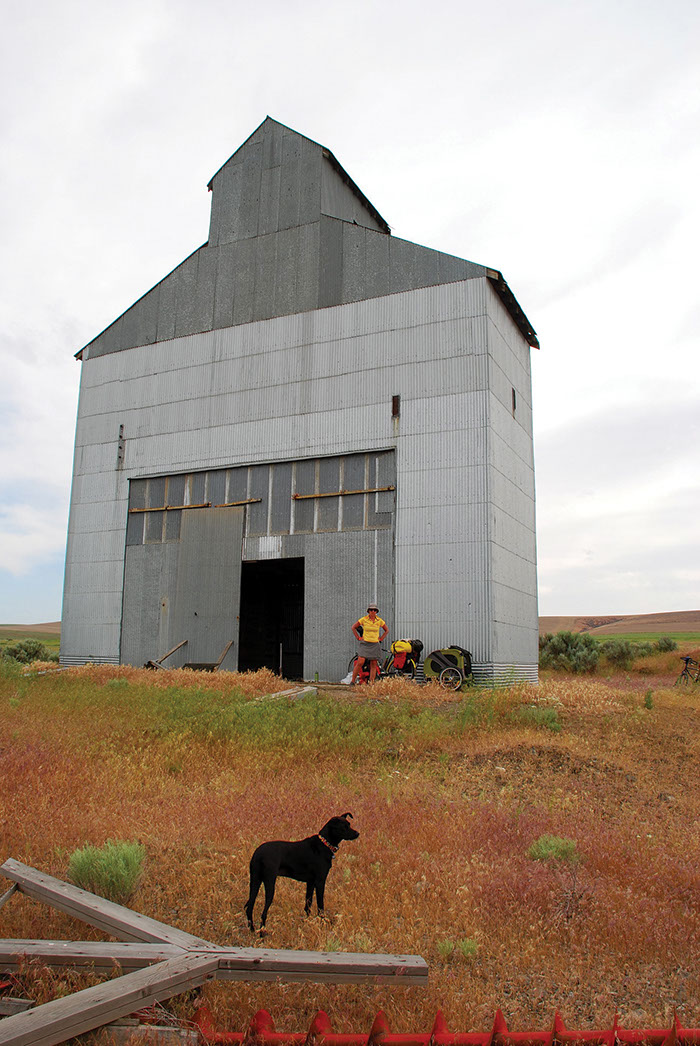
The 20-mile detour, due to the damaged Beverly Bridge, requires cyclists to pedal north up to the I-90 bridge, cross the span in the company of speeding semis, and then pedal south along a busy, winding state highway to pick up the trail at Beverly. I read of cyclists who crossed the narrow interstate bridge as quickly as possible, dropping flares as they rode to alert traffic. I’m not sure we would have crossed on our own, but with Tiva in tow, it just wasn’t possible.
Fortunately we had our own trail angels. Marilyn Hedges and Mike Sorensen, dedicated advocates of the trail, offered to shuttle us across the river when they heard of our planned trip with Tiva. They camped with us at Wanapum State Park and shuttled us across the next morning. They then drove their vehicle with their bikes and gear to Tekoa. This allowed us to have a vehicle to drive back to Seattle and allowed Mike and Marilyn to bike the trail east to west and then pick up their vehicle from us.
Days later, we all ended up at the Top Hat Motel in Ritzville where we took advantage of “steak and potato night” at the local pub and watched the local high-school band and parade practice on the main street. In the morning, Mike and Marilyn pedaled west, and we continued east.
Not many cyclists do the whole trail. East of the Columbia, the trail is rough, to say the least. There are detours due to missing trestles, active rail, and private property issues. There are no trailside campgrounds like there are on the western section. Food and services are few and far between.
But I can tell you — it’s worth it. The eastern section travels through old train towns, ranches, and farmland. It winds through the rugged scablands and the fertile grassland and farmland of the Palouse. Each day brought with it small travel gems. In the town of Warden, a kind woman at Las Tres Amigas restaurant brought lounge chairs out to the parking lot so we could eat our lunch with Tiva. Kat still dreams about the ham salad sandwiches we bought at the grocery store in the lovely town of Lind. In the tiny town of Malden, a woman in a bright green tracksuit, paired with a vivid red hat and gloves, called out, “I’m your greeter. Welcome to Malden.” She let us know that we could camp at the city park. If we called the number on the information sign, the mayor would come out and unlock the shower and restrooms for us. We were tempted, but we pushed on to Rosalia where we camped at the city park. We ate at the pizza parlor, and the owners let Tiva come in and curl up next to our table.
Those people connections were few and far between. For most of the journey, we were on our own, surrounded by beauty and nature. We saw deer bounding through wheat fields; flushed out a coyote in the middle of the afternoon; watched plovers and avocets wading in wetlands; felt the rumble of elk pass by our tent in the middle of the night. Kat identified 36 different kinds of wildflowers. We even encountered a couple of rattlesnakes that were far more wary of us than we were of them.
One evening as I finished setting up our tent, I looked up and was taken aback by a flock of white pelicans. The breeze was such that they were hanging in the air like a dozen balloons. I got Kat’s attention, and, as if they were waiting for us, the pelicans began these slow-motion maneuvers — an avian drill team. After a couple of minutes, they spanned out into a long line and banked one by one out of sight over the tops of towering ponderosa pines.
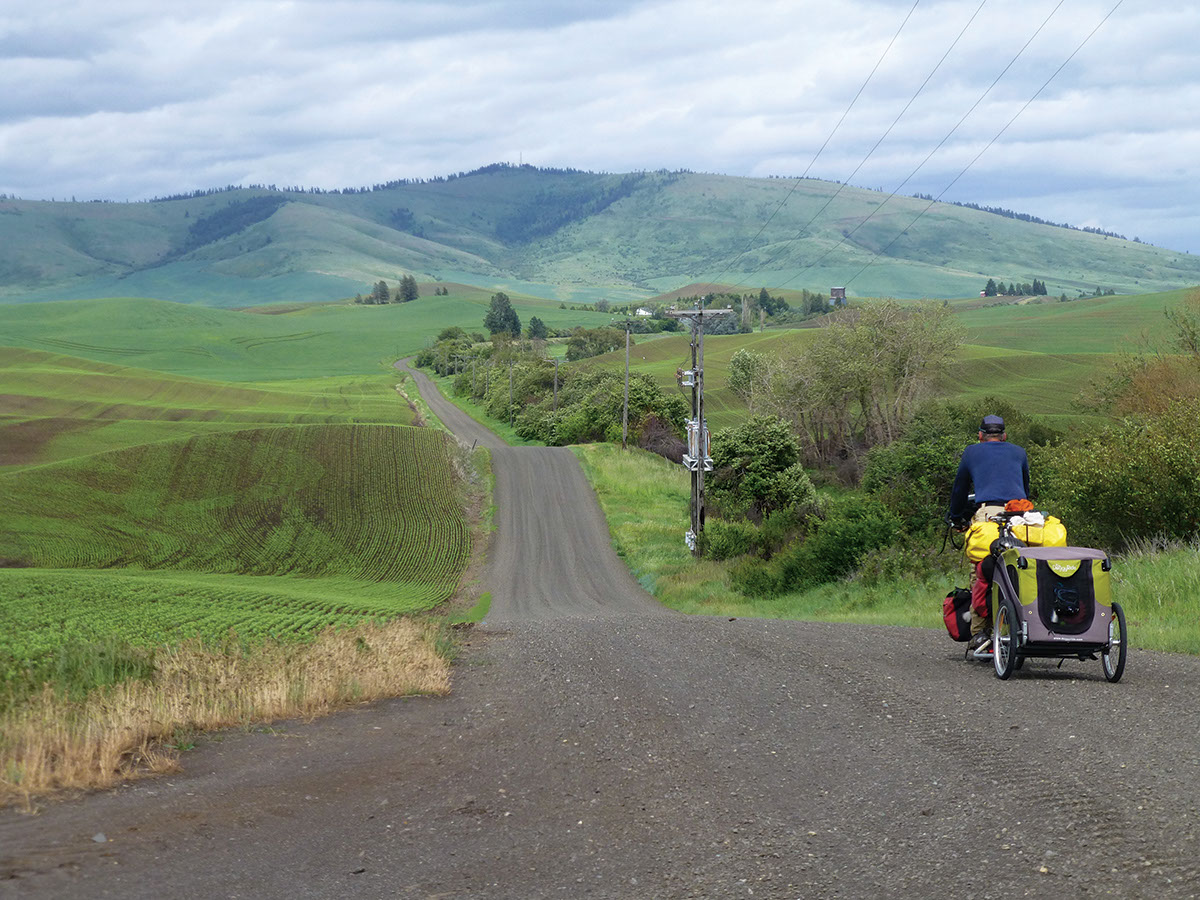
City dwellers that we are, traveling on the trail represented a welcome lack of traffic and plane noise. We had crossed eastern Washington dozens of times but always in a car on the interstate. This trail allowed us to experience a part of our state we had never truly explored.
How did our Reluctant Traveler fare? She turned into Tiva the Wonder Dog! She typically ran between five and seven miles a day. I’d swear she was smiling as she bounded through the tall grass or trotted along the railbed. Each day brought a thousand new smells. She grew more relaxed in the trailer as well, but it took more effort than we imagined for her to ride in it along rocky railbeds. If it’s true that “a tired dog is a good dog,” then she was the best. The second the tent was pitched at the end of the day, she dove in, curled up, and went to sleep. She was so tired one evening that she ate her dinner lying down.
We woke up on the last day of our ride to wind and rain battering our tent at the city park in Rosalia. We made some coffee, procrastinating to see whether the weather would shift. We finally headed out to the trail and battled against a stiff headwind. The loose ballast made the going slow. There were several gates to open and close along the way. About eight plodding miles later, I decided to check the GPS on our phone to see where we were on the trail.
“You’re not going to like this,” I shouted over the wind. “We’re going the wrong way.”
Kat looked at the map and the little flashing blue dot indicating our location and said, “I think I may weep.”
How could we have possibly made that mistake?
When we had left Malden, the trail was rough going. We’d heard that this was one of the roughest sections of the trail. The road into Rosalia had little to no traffic so we had decided to take it. It climbed a steep hill, but after so many miles of bumpy ballast, we had embraced the climb on smooth pavement. We were confused about where we had entered Rosalia, so in the morning we headed off in the wrong direction. The trail didn’t look familiar because we hadn’t ridden that section.
We asked some locals who kindly pointed out a road we could take to get back to the road we’d ridden the day before. We repeated the steep climb and descent into Rosalia, and, after hours of pedaling, we had made not an inch of progress.
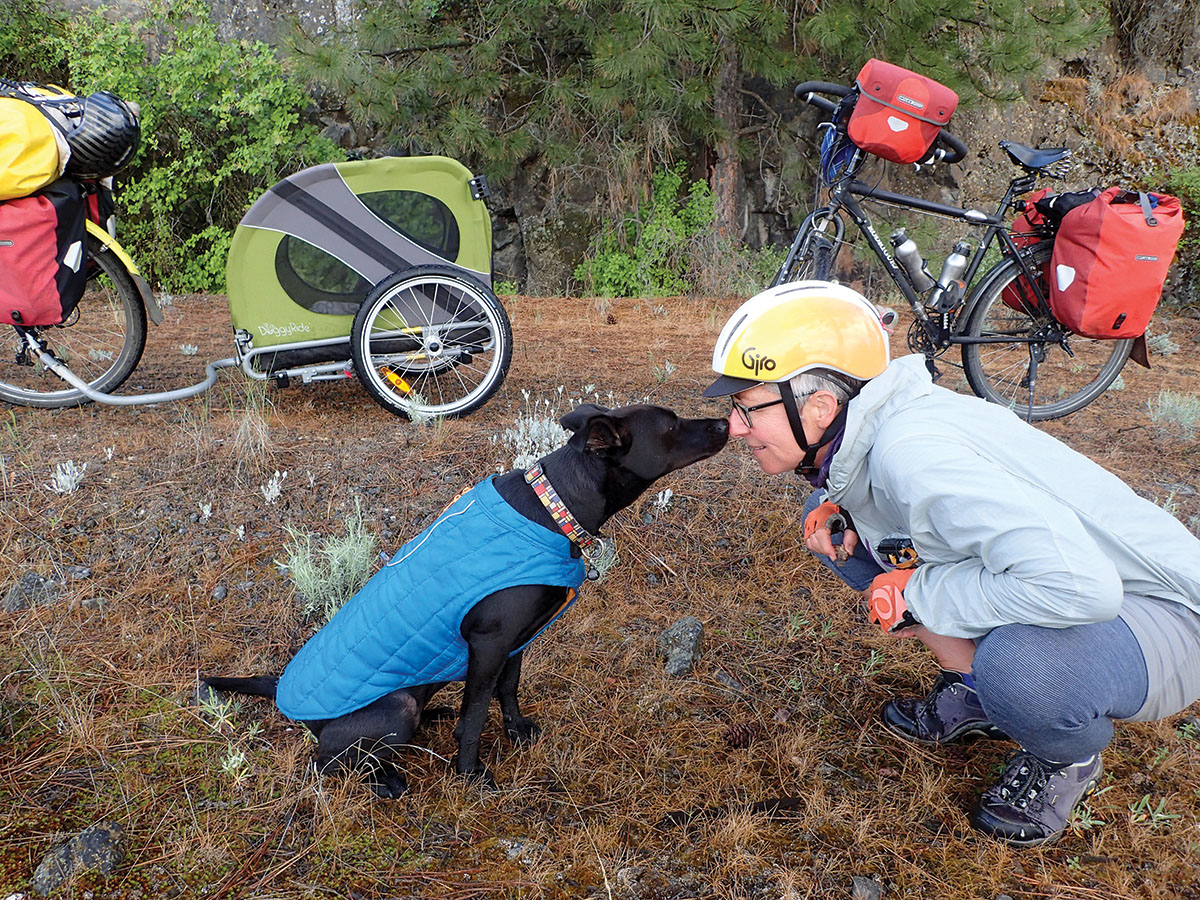
It was slow going, and we once again had a stiff headwind. It was time for Tiva to earn her kibble. Because we were going slowly, I had her get out of the trailer and trot alongside of us … for 12 miles. She loved it. And, with the cooler temperatures, we weren’t concerned that she’d overheat.
Then the wind really picked up. There were moments when gusts would slam into me and I’d have to put a foot down to avoid being blown over. Kat was out in front with Tiva running back and forth between us. Kat was 300 yards ahead and began to cross a trestle. When I looked up again, she was off her bike and running toward us waving her arms. Tiva shot straight for her. She came running off the trestle and grabbed Tiva.
I couldn’t understand what she was doing until I saw that the trestle had a high guardrail but no fencing. The wind was whipping through the cut with such force that a gust would have blown Tiva straight over the edge.
We got Tiva into the trailer, and with hearts still racing, we braced ourselves against the wind and walked slowly across the trestle. Tragedy averted.
The wind finally died down, and we made our way through the lush green corridor as the sun broke out and shown on the hilly farmland surrounding us. And just as our legs felt as if they’d had enough … there was the Tekoa trestle. Although we couldn’t arrive in Tekoa via that trestle (it is one of many that need repair), it announced that we’d made it.
But, most important, Tiva had made it. A dog that had been too afraid to walk 50 feet down a city sidewalk had just walked, sprinted, and ridden over 300 miles.
Our three-year journey to complete a nine-day trip was a grand success. We learned that it takes a ton of love, patience, and persistence to rehabilitate a rescued dog. The same can be said about advocating for a trail. In both cases, the rewards are immeasurable.
We hope to ride the trail again someday (hopefully soon) when we will be able to arrive via that trestle. A group of trail advocates called the Tekoa Trail and Trestle Association has helped spearhead the latest effort to save the trail. There is a current grant request from state parks to renovate the trestle, along with many other projects to improve the trail.
For dreamers and advocates, the grand picture is filled with promise, but there’s a whole lot of work to do.
Nuts & Bolts
If you are interested in cycling and/or supporting the John Wayne Pioneer Trail, your first stop should be friendsofjohnwaynepioneertrail.org. This site is a treasure of information, including maps, links, photos, and history. Because this is a trail “in progress,” updated information is crucial. You currently need two permits (free for groups of fewer than 20) to travel the portion of the trail east of the Columbia River. There are also detours around areas that are missing trestles and some sections with private land and active rail. There is a linked GPS map with cue sheets and comments that is incredibly helpful. The site has links to trip reports, history of the trail, and updates on scheduled meetings and events to benefit the trail.
When to Go
Riding the entire route is best done in the shoulder seasons (September–October and May–June). The Snoqualmie tunnel is closed during winter (generally November until May). July and August are possible, but riders need to understand and be prepared for high heat conditions in eastern Washington with limited water available.
Where to Begin
We began our journey at the trailhead east of Seattle, but it is possible to leave from Seattle and ride mostly on off-road trails to the Cedar Falls trailhead.
What Kind of Bike
We traveled with touring bikes (Rodriguez UTB) running 26 x 1.9in. Schwalbe Marathon Plus tires. Tiva’s trailer is made by DoggyRide and was running 20 x 1.5in. Schwalbe Marathon tires. We used tire sealant for all our tubes due to goathead thorns in the eastern portion of the trail. Plenty of folks have traveled the route with mountain bikes or fat bikes. Shocks would definitely ease the jarring from the rough railbeds in the eastern portion.

